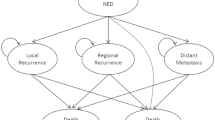Abstract
Background
Cost can be a major issue in therapeutic decision-making and in particular for patients with locally advanced non-small cell lung cancer (LA-NSCLC).
Methods
The specific aim of this analysis was to evaluate the costs and outcomes of patients treated on Radiation Therapy Oncology Group (RTOG) 94-10, Medicare Part A and Part B costs from all for patients treated from 1991 to 1996 on RTOG 94-10, a phase III trial showing a survival benefit for concurrent chemoradiation (STD RT) over sequential (RT day 50) chemoradiation in LA-NSCLC with intermediate outcome for concurrent twice daily radiation and chemotherapy (HFX RT). Twenty-six-month expected costs for each arm of the trial in 1996 dollars were determined, with Kaplan-Meier sampling average estimates of survival probabilities for each month and mean monthly costs. The analysis was performed from a payer’s perspective. Incremental cost-effectiveness ratios were calculated comparing RT on day 50 and HFX RT to the STD RT.
Results
Of the 610 patients entered, Medicare cost data and clinical outcomes were available for 92 patients. In this subset, compared to STD RT, RT on day 50 proved less costly but resulted in reduced survival at 1 year. In addition, HFX RT costs slightly more than STD RT but was less effective in this cohort of patients.
Conclusions
In patients with Medicare insurance and with significant toxicity burden, RT on day 50 is the least expensive but also least effective treatment in this subset of patients treated on RTOG 94-10.



Similar content being viewed by others
References
Curran WJ Jr, Paulus R, Langer CJ et al (2011) Sequential vs. concurrent chemoradiation for stage III non-small cell lung cancer: randomized phase III trial RTOG 9410. J Natl Cancer Inst 103(19):1452–1460
Hillner BE (1995) Potential evaluation of the incremental cost-effectiveness of paclitaxel in advanced non-small-cell lung cancer (Eastern Cooperative Oncology Group 5592). J Natl Cancer Inst Monogr 19:65–67
Evans WK, Will BP, Berthelot JM, Earle CC (1997) Cost of combined modality interventions for stage III non-small-cell lung cancer. J Clin Oncol 15(9):3038–3048
Thongprasert S, Permsuwan U, Ruengorn C, Charoentum C, Chewaskulyong B (2011) Cost-effectiveness analysis of cisplatin plus etoposide and carboplatin plus paclitaxel in a phase III randomized trial for non-small cell lung cancer. Asia Pac J Clin Oncol 7(4):369–375
Dickson R, Bagust A, Boland A, et al. Erlotinib monotherapy for the maintenance treatment of non-small cell lung cancer after previous platinum-containing chemotherapy: a NICE single technology appraisal. Pharmacoeconomics 29(12):1051–62
Sher DJ, Wee JO, Punglia RS (2011) Cost-effectiveness analysis of stereotactic body radiotherapy and radiofrequency ablation for medically inoperable, early-stage non-small cell lung cancer. Int J Radiat Oncol Biol Phys 81(5):e767–e774
Konski A, Bhargavan M, Owen J, Paulus R, Cooper J, Forastiere A, Ang KK, Watkins-Bruner D (2011) Feasibility of economic analysis of Radiation Therapy Oncology Group (RTOG) 91-11 using Medicare data. Int J Radiat Oncol Biol Phys 79(2):436–442
Konski A, Bhargavan M, Owen J, Paulus R, Cooper J, Fu KK, Ang K, Watkins-Bruner D (2008) Feasibility of using administrative claims data for cost-effectiveness analysis of a clinical trial. J Med Econ 11(4):611–623
Warren JL, Brown ML, Fay MP, Schussler N, Potosky AL, Riley GF (2002) Costs of treatment for elderly women with early-stage breast cancer in fee-for-service settings. J Clin Oncol 20(1):307–316
Manning WG, Fryback DG, Weinstein MC (1996) Reflecting uncertainty in cost-effectiveness analysis. In: Gold MR, Siegel JE, Russell LB, Weinstein MC (eds) Cost-effectiveness in health and medicine. Oxford University Press, New York, pp 247–275
Fenwick E, Byford S (2005) A guide to cost-effectiveness acceptability curves. Br J Psychiatry 187:106–108
Fenwick E, O'Brien BJ, Briggs A (2004) Cost-effectiveness acceptability curves—facts, fallacies and frequently asked questions. Health Econ 13(5):405–415
Drummond M (2001) Introducing economic and quality of life measurements into clinical studies. Ann Med 33(5):344–349
Bennett CL, Armitage JL, Buchner D, Gulati S (1994) Economic analysis in phase III clinical cancer trials. Cancer Investig 12(3):336–342
Bennett CL, Armitage JL, LeSage S, Gulati SC, Armitage JO, Gorin NC (1994) Economic analyses of clinical trials in cancer: are they helpful to policy makers? Stem Cells 12(4):424–429
Bennett CL, Smith TJ, George SL, Hillner BE, Fleishman S, Niell HB (1995) Free-riding and the prisoner’s dilemma: problems in funding economic analyses of phase III cancer clinical trials. J Clin Oncol 13(9):2457–2463
Bennett CL, Westerman IL (1995) Economic analysis during phase III clinical trials: who, what, when, where, and why? Oncology (Williston Park) 9(11 Suppl):169–175
Mauskopf J, Schulman K, Bell L, Glick H (1996) A strategy for collecting pharmacoeconomic data during phase II/III clinical trials. PharmacoEconomics 9(3):264–277
Author information
Authors and Affiliations
Corresponding author
Ethics declarations
Funding sources
This work was supported by the Pennsylvania Commonwealth Universal Research Enhancement (C.U.R.E.) Program ME-02-149 grant. This trial was conducted by the Radiation Therapy Oncology Group (RTOG) and was supported by RTOG grant U10 CA21661 and CCOP grant U10 CA37422 from the National Cancer Institute (NCI).
Conflict of interest
The authors declare that they have no conflict of interest.
Ethical approval
As this study involved patients no animals had been involved in this study. All applicable international, national, and/or institutional guidelines for the care and use of animals were followed.
Informed consent
All patients who initially participated in this clinical study have given informed consent. All human studies have been approved by the appropriate ethics committee and have therefore been performed in accordance with the ethical standards laid down in the 1964 Declaration of Helsinki and its later amendments. All persons gave their informed consent prior to their inclusion in the original study.
Rights and permissions
About this article
Cite this article
Konski, A., Bhargavan, M., Owen, J. et al. An economic analysis of Radiation Therapy Oncology Group 94-10: cost-efficacy of concurrent vs. sequential chemoradiotherapy. J Radiat Oncol 7, 195–201 (2018). https://doi.org/10.1007/s13566-018-0346-7
Received:
Accepted:
Published:
Issue Date:
DOI: https://doi.org/10.1007/s13566-018-0346-7




